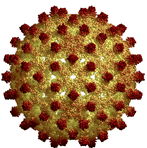| Treatment
of HIV-HBV Coinfected Patients in South Africa By
Liz Highleyman
HIV-HBV
Coinfection |  | This
picture shows the structure of the Human Immunodeficiency Virus(HIV). | | This
picture shows the structure of the Hepatitis B Virus (HBV). |
Due
to overlapping transmission routes, many people are infected with both HIV
and hepatitis B virus (HBV). This is especially
the case in parts of the world -- such as Africa and Asia -- where hepatitis B
is endemic, and in resource-limited settings where HBV
vaccination is not widespread.
Response
to HAART
A
retrospective cohort study reported in the December 1, 2008 issue of Clinical
Infectious Diseases evaluated the impact of chronic hepatitis B on HIV virological
response, changes in CD4 cell count, hepatotoxicity, and mortality among patients
receiving HAART through a workplace program in South Africa during 2001-2006.
Participants
were antiretroviral-naive and received HAART
according to the program protocol, consisting of efavirenz
(Sustiva or Stocrin), zidovudine
(AZT; Retrovir) and lamivudine
(3TC; Epivir -- a drug with activity against both HIV
and HBV).
On the basis of pre-HAART
serum testing, patients were classified according to hepatitis B surface antigen
(HBsAg) status (negative or positive) and HBV DNA level (< or > 10,000
copies/mL). A total of 537 individuals fulfilled the inclusion criteria; 431 (80.3%)
were HBsAg negative -- indicating they did not have chronic hepatitis B -- while
106 (19.8%) were HBsAg positive. In the latter group, 60 (11.2%) had low HBV DNA
and 46 (8.6%) had high HBV DNA.
Participants were followed for up to 72
weeks. Relationships between HBV status and HIV RNA suppression, changes in CD4
cell count, mortality, and hepatotoxicity -- defined as transaminase (ALT and/or
AST) levels 5 or more times the upper limit of normal -- were assessed using regression
techniques.
Results
•
Participants in the HBsAg negative, HBsAg positive low HBV DNA, and HBsAg positive
high HBV DNA groups had similar rates of HIV viral load suppression > 400 copies/mL
(P = 0.61), CD4 cell count increases (P = 0.75), and mortality (P = 0.11) for
up to 72 weeks after HAART initiation.
•
Baseline transaminase levels were highest in the group with high HBV DNA (P =
0.004).
•
Frequency of hepatotoxicity was similar in the HBsAg negative group and the HBsAg
positive low HBV DNA group, but higher in the HBsAg positive high HBV DNA group
(incidence rate ratio 4.4).
•
Serious grade 3 or 4 liver toxicity was uncommon overall (23 patients total).
•
The highest hepatotoxicity rate was observed in the HBsAg positive high HBV DNA
group (17 per 100 person-years) compared with the HBsAg low HBV DNA group (1.7
per 100 person-years) and the HBsAg negative group (3.8 per 100 person-years).
"We
revealed that HBV status does not affect HIV RNA suppression, CD4 cell count response,
or mortality during the first 72 weeks of HAART in an African setting," the
investigators concluded.
But, they added, "The risk of HBV-associated
hepatotoxicity, however, is associated with the baseline HBV DNA level."
The
researchers noted that most instances of serious transaminase elevation occurred
within 6 months of starting HAART -- and were likely attributable to immune reconstitution
inflammatory syndrome -- but 3 cases occurred after 6 months.
In an accompanying
editorial, Vincent Soriano of Hospital Carlos III in Madrid, Spain, and colleagues
wrote that given the high rate of hepatitis B in the South African population,
all HIV positive individuals should be screened for HBV, and those who are HBV
negative should receive the hepatitis B vaccine.
While several studies
have shown poorer CD4 cell recovery after starting antiretroviral therapy in patients
with HIV-HCV coinfection -- though data have been mixed -- this does not appear
to be the case for HIV-HBV coinfected individuals.
Aurum Institute for
Health Research and Toga Laboratories, Johannesburg, South Africa; University
of Pretoria, Pretoria, South Africa; Johns Hopkins University School of Medicine,
Baltimore, MD; London School of Hygiene and Tropical Medicine, London, UK.
Liver
Disease Progression
In
a related study presented at the 59th Annual Meeting of
the American Association for the Study of Liver Diseases (AASLD 2008) this
past fall, investigators looked at liver disease progression -- necroinflammatory
activity and fibrosis -- among HIV-HBV coinfected patients in South Africa.
A
total of 30 HIV positive patients with chronic hepatitis B who had previously
undergone liver biopsy were selected, and were compared to a group of 30 HIV negative
control subjects with chronic hepatitis B monoinfection matched for age and HBV
serological profile.
In both groups, 63% were hepatitis B "e"
antigen (HBeAg) positive and 37% were HBeAg negative. The HIV-HBV coinfected group
had relatively advanced HIV disease, with a median CD4 count of 117 cells/mm3.
Results
•
The median alanine aminotransferase (ALT) level at the time of biopsy was 118
U/L in the coinfected group and 104 U/L in the HBV monoinfected group, a non-significant
difference.
•
Necroinflammatory activity was significantly greater in the HIV-HBV coinfected
group compared with the HBV monoinfected group (median 7.6 vs 4.6 on the Ishak
modified Histological Activity Index scale; P = 0.0002).
•
Liver fibrosis scores were also significantly greater in the coinfected compared
with the HBV monoinfected group (median 3 vs 1; P < 0.0076).
•
Findings were similar regardless of HBeAg status.
"Hepatitis
B related necroinflammatory activity and fibrosis was significantly greater in
HIV-HBV coinfected than in HBV monoinfected patients," the researchers concluded.
"This was despite advanced immunosuppression in the coinfected group and
similar transaminase levels and HBV viral loads in both groups."
This
finding, they added, "may predict for a worse long term liver morbidity and
mortality outcome in coinfected patients in the setting of endemic HBV infection."
1/09/09
References
CJ
Hoffmann, S Charalambous, DJ Martin, and others. Hepatitis B Virus Infection and
Response to Antiretroviral Therapy (ART) in a South African ART Program.
Clinical
Infectious Diseases 47(11): 1479-1485. December 1, 2008. (Abstract). V
Soriano, P Rivas, and M Nunez. Risks and benefits of using antiretroviral therapy
in HIV-infected patients with chronic hepatitis B in developing regions. Clinical
Infectious Diseases 47(11): 1486-1489. December 1, 2008.
MW Sonderup,
H Wainwright, HN Hairwadzi, and others. A clinicopathological comparison of HIV/Hepatitis
B co-infection and Hepatitis B mono-infection in Cape Town, South Africa. 59th
Annual Meeting of the American Association for the Study of Liver Diseases (AASLD
2008). San Francisco. October 31-November 4, 2008. Abstract 1936 |

![]()

